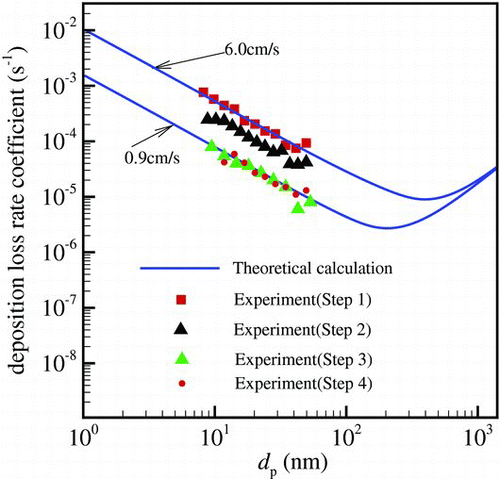Abstract
A thorough understanding of the importance of aerosol coagulation and deposition relative to each other as modifiers of the particle size distribution plays an important role in the proper selection of conditions to estimate the deposition rate coefficient. In this work, a theoretical analysis was conducted for investigating the size-resolved ratio of coagulation to deposition for different types of size distributions using the Simpson integral method. The theoretical model was subsequently qualitatively validated by experiments in a completely mixed and ventilated aerosol chamber. Both experimental and theoretical studies show that the ratio of the rates of coagulation to deposition is strongly dependent on the total particle number concentration and the geometric mean diameter of the aerosol. A variation of the ratio of coagulation to deposition by several orders of magnitude for aerosols with differing size distributions was found. Thus the previously employed criterion for the negligence of coagulation based solely on the total particle number concentration was shown to be insufficient to accurately judge whether an aerosol is suited for the estimation of the deposition rate coefficient. Aerosols with wide size distributions are not recommended for use in the estimation of the deposition rate coefficient. The study provides a method to understand the role of coagulation and deposition for indoor aerosols.
Copyright 2013 American Association for Aerosol Research
1. INTRODUCTION
Deposition may be a dominant particle removal mechanism for nanoparticles and coarse particles in workplaces (Nazaroff and Cass 1984; Xu et al. Citation1994; He et al. Citation2005; Lai and Nazaroff Citation2005). The particle deposition rate coefficient is, therefore, an essential parameter to estimate the fate of particles in an enclosed space or indoor environment, and it is also a key quantity when particle size-resolved emission rates or sink rates are characterized (Lai et al. Citation2002; Hussein et al. Citation2009, Citation2012; Koivisto et al. Citation2010; Koivisto et al. 2012). Nowadays, using size-resolved measurements such as scanning mobility particle sizers (SMPS), optical particle counters (OPC), and aerodynamic particle sizers (APS), the deposition rate coefficient is generally estimated from measured data for aerosols with low number concentration where coagulation can supposedly be ignored when compared to deposition (Lai Citation2002; Lai et al. Citation2002; Riley et al. Citation2002; Thatcher et al. Citation2002; He et al. Citation2005; Lai and Nazaroff Citation2005; Lai Citation2006; Hussein et al. Citation2009). However, up to now, there is a lack of fundamental understanding regarding the ratio of the rates of coagulation and deposition for aerosols with wide size distributions. It is, therefore, unclear as to which criteria an aerosol has to fulfill in order to be able to neglect coagulation relative to deposition, which is prerequisite for the estimation of the deposition rate coefficient. In addition, the deposition and coagulation magnitudes are also key parameters when exposure from source to receptor is considered.
Currently, the widely used approach assumes that if coagulation is negligible the evolution of the number concentration takes the following form (Hussein et al. Citation2009; Koivisto et al. 2012),
In order to judge whether size effects can be ignored in a definition of a suitable criterion, the relative importance of coagulation compared to deposition needs to be evaluated over the entire range of the size distribution of an aerosol. A critical value of this ratio of coagulation to deposition is then proposed as a more suitable criterion. However, there are very few studies available in the literature addressing this issue. Due to the basic difference between the coagulation and deposition mechanisms (Friedlander Citation2000; Chan et al. Citation2006; Lin et al. Citation2007; Schripp et al. Citation2008; Rim et al. Citation2012), the relative ratio of coagulation to deposition rapidly decreases with the decrease of the total particle number concentration. In experimental studies, however, the particle number concentration cannot be decreased without limitation since the statistical error of the measurement instrumentation becomes too large to measure reliable concentrations. Therefore, we need to know what concentration is suitable for the estimation of the deposition rate coefficient for an aerosol in a ventilated space for a given size distribution. In order to facilitate the proposal of a reasonable criterion, the basic features of the relative importance of coagulation and deposition as a function of the particle size and the type of size distribution need to be known. In the present study, a theoretical analysis of the problem was performed for different size distributions including uni-modal and bi-modal distributions. In order to validate the theoretical studies, a series of experiments involving a nanoparticle aerosol and a submicron oil aerosol were conducted in a ventilated and mixed experimental chamber, which has been previously used studying the temporal evolution of nanoparticle aerosol dynamics (Seipenbusch et al. Citation2008) and for observing size-resolved emission rates in an evolving aerosol system (Koivisto et al. 2012) Due to a steady flow and complete mixing inside the chamber, the governing equation for the evolution of the particle size distribution can be constructed without considering transport, and thus the experiment is easier to be analyzed using models. In this study, the experiments were conducted to validate the theoretical analysis through investigating the relative ratio of coagulation to deposition.
The present work is composed of two parts, i.e., the theoretical study and the experimental study for the relative ratio of coagulation to deposition in uni-modal and bi-modal size distributions. The specific objectives of the study include (1) revealing the basic features of the ratio of coagulation to deposition rates over the entire size range for different types of size distributions of an aerosol in a ventilated space; (2) evaluating the effectiveness of the existing criterion in terms of the total particle number concentration; and (3) proposing a more reasonable criterion.
2. MATERIALS AND METHODS
2.1 Experimental Setup and Measurement
The data used in this study are from Koivisto et al. (Citation2012) where the experimental setup and instrumentation were fully described. The experimental setup consisted of an aerosol chamber (1×1×2 m3), where gold nanoparticles and/or DEHS (Bis(2-Ethylhexyl)-Sebacat) oil particles were injected. The chamber was operated under atmospheric pressure and aerosol mixing was ensured with a fan whose speed was adjustable. Carrier gas of the gold NPs were nitrogen with a volume flow of 4.8 lpm and for DEHS particles air with a volume flow rate of 0.8 lpm. The chamber was ventilated with particle-free air between the experiments. Particle size distribution time series were measured separately or together with a scanning mobility particle sizer (SMPS, TSI model 3080 classifier with a TSI 0.071 cm pre-impactor, TSI model 3077A neutralizer, TSI differential mobility analyzer model 3081) and the white light aerosol spectrometer (WELAS, Palas Promo 2000 with WELAS 2100 detector; flow rate 4.8 l pm). The particle size distributions were measured in 135 s intervals to provide good time resolution, and it covered particle size range from around 5 nm to around 10 μm. For SMPS and WELAS, the sampling and shear flow rates have been shown in (Koivisto et al. 2012), and they were chosen in that the aerosol whole size range can be covered.
2.2. Theory and Theoretical Method
Based on the Smoluchowski mean-field theory, the particle general dynamical equation takes the following form (Friedlander Citation2000):
In the atmospheric environment, the size distribution of an aerosol usually follows a log-normal distribution or the sum of a few log-normal distributions (Whitby Citation1978). Without loss of generality, in this study, the particle size distribution was assumed to take the following form:
FIG. 1 Changes of dN/dlogd p and |γ| with respect to particle diameter for aerosols with GMD = 5.4 nm (D1), 23.0 nm (D2), 120.0 nm (D3), 537.0 nm (D4), and 2684.8 nm (D5) at the same total particle number concentration of 1.0 × 104 cm−3 and the same geometric standard deviation of 1.5. (Color figure available online.)
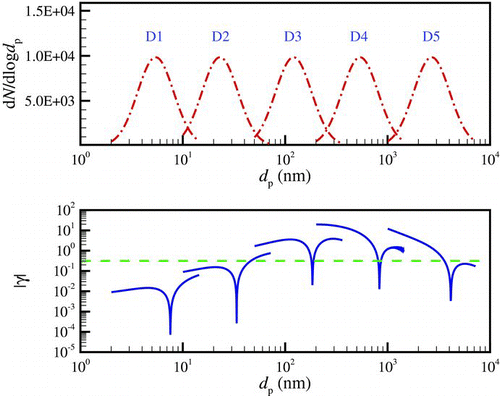
In this study, the ratio of coagulation to deposition rates will be observed by the following equation:
3. RESULTS AND DISCUSSION
3.1. Theoretical Studies
The size-resolved ratio of coagulation to deposition over the entire size range was investigated. shows the changes of dN/dlogd p and |γ| with respect to particle diameter, in which five uni-modal log-normal distributions were employed. In order to investigate the effect of particle size on the ratio of coagulation to deposition rates, five different geometric mean diameters (GMD), i.e., 5.4, 23.0, 120.0, 537.0, and 2684.8 nm, with the same geometric standard deviation (GSD) (σ g = 1.5) and the same total particle number concentration (1.0 × 104 cm−3) were observed and compared. The total particle number concentration was selected in that it is the criterion for ignoring coagulation in Hussein et al. (Citation2009), and the geometric standard deviation was selected because it is the value measured in chamber studies which will be further investigated below (Koivisto et al. 2012). The deposition rate coefficient was calculated from the model proposed by Lai and Nazaroff (Citation2000) with a friction velocity of 0.9 cm/s, where the input parameters, including the vertical surface, the upward horizontal surface and the downward horizontal surface areas, are identical to that in the experimental geometry in Koivisto et al. (2012). The friction velocity, 0.9 cm/s, was selected because it is considered to be a value for the friction velocity in the chamber study conducted by Koivisto et al. (2012), which will be further illustrated in and . For convenient comparison between the experimental and the theoretical studies, the GMD and GSD in D2 and D3 are nearly the same as the following experimental studies in and , respectively.
FIG. 2 The evolution of particle size distribution as well as its total particle number concentration and its GMD with time measured with the SMPS. (Color figure available online.)
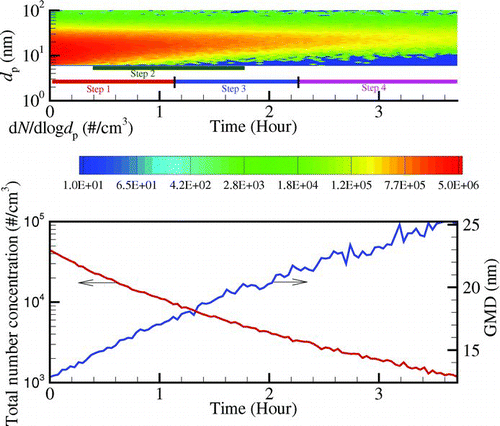
The absolute value of γ is used in because in the high end of each size distribution the value of γ will be changed from positive to negative. This is because, in a log-normal size spectrum, the time rate of the coagulation term is negative in almost all size range (![]() ), except in the high end of size spectrum where it is positive (
), except in the high end of size spectrum where it is positive (![]() ). In this figure, for each size distribution, the value of |γ| changes with the particle size, and especially it spans nearly one order in magnitude or more. If the criterion of ignoring coagulation is defined with |γ|⩽0.3, it is found only in the distributions of D1 and D2 coagulation can be ignored meaning this distribution is suitable for the estimation of deposition rate coefficient with the total particle number concentration of 1.0 × 104 cm−3. When the particle size is increased, i.e., the distributions of D3, D4, and D5, coagulation cannot be ignored because it is significant relative to deposition. Therefore, the criterion of ignoring coagulation using only the total particle number concentration is insufficient to evaluate whether an aerosol is suitable for the estimation of the deposition rate coefficient. If the particle size of an aerosol increases more, deposition will predominate again due to the strong sedimentation mechanism, but the study in this size range is beyond the scope of this study.
). In this figure, for each size distribution, the value of |γ| changes with the particle size, and especially it spans nearly one order in magnitude or more. If the criterion of ignoring coagulation is defined with |γ|⩽0.3, it is found only in the distributions of D1 and D2 coagulation can be ignored meaning this distribution is suitable for the estimation of deposition rate coefficient with the total particle number concentration of 1.0 × 104 cm−3. When the particle size is increased, i.e., the distributions of D3, D4, and D5, coagulation cannot be ignored because it is significant relative to deposition. Therefore, the criterion of ignoring coagulation using only the total particle number concentration is insufficient to evaluate whether an aerosol is suitable for the estimation of the deposition rate coefficient. If the particle size of an aerosol increases more, deposition will predominate again due to the strong sedimentation mechanism, but the study in this size range is beyond the scope of this study.
FIG. 3 The evolution of the particle size distribution as well as its total particle number concentration and its GMD with time measured with the SMPS. (Color figure available online.)
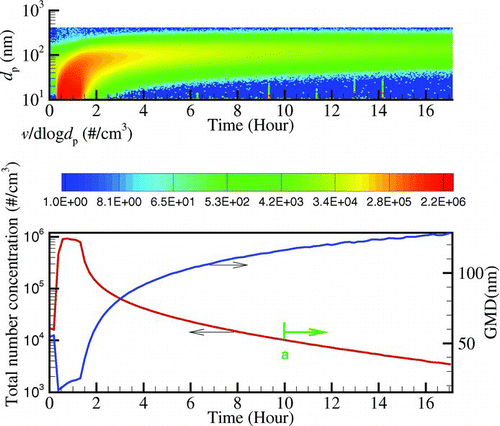
From the comparisons among five distributions in , they have a difference of several orders in magnitude for small GMD and large GMD, even though they have the same total particle number concentration. When the GMD is relatively small (D1 and D2), |γ| increases with the increase of particle diameter; for median GMD (D3), it initially increases to a maximum at ∼120 nm and then decreases with the particle diameter. For large GMD (D4 and D5), however, |γ| decreases with the increase of the particle diameter. From the theoretical calculation by the model of Lai and Nazaroff (Lai and Nazaroff Citation2000), the minimum of the deposition rate coefficient also occurs at ∼120 nm for the present investigated chamber with a friction velocity of 0.9 cm/s, shown in . Although the variation of |γ| over the entire size range arises from the competition of coagulation and deposition, the deposition may play a key role in determining the location of the maximum of |γ|. It should be pointed out here that in the size range below ∼120 nm, the Brownian and turbulent diffusions are dominant while in the size range larger than this size value the sedimentation is dominant. Therefore, if the particle number loss of an aerosol is mainly dominated by the turbulent and Brownian diffusion mechanism, then the ideal candidate aerosol to be used in the estimation of deposition rate coefficient should be that with lower total particle number concentration.
FIG. 4 Changes of dN/dlogd p and |γ| with respect to particle diameter for aerosols with GMD = 5.4 nm (D1), 23.0 nm (D2), 120.0 nm (D3), 537.0 nm (D4), and 2684.8 nm (D5) at the same geometric standard deviation of 1.5 and the same friction velocity of 0.9 cm/s with the criterion with |γ|⩽0.3. The total particle number concentrations for D1′, D2′, D3′, D4′ and D5′ are 1.0 × 105, 1.0 × 104, 1.0 × 103, 2.0 × 102, and 5.0 × 102 cm−3, respectively. (Color figure available online.)
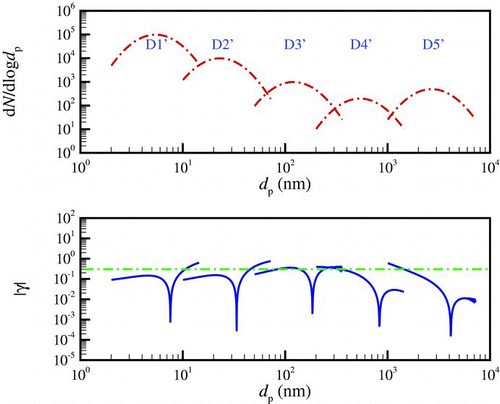
Based on the Simpson integral calculation for coagulation and deposition terms in EquationEquation (2), it is also easy to obtain what the total particle number concentration satisfies the criterion with |γ|⩽0.3 for different size distributions shown in . If the criterion with |γ|⩽0.3 is applied to aerosols having the same GSD and the same GMD as D1, D2, D3, D4, and D5 in , the total particle number concentrations for them should be equal to or less than 1.0 × 105, 1.0 × 104, 1.0 × 103, 2.0 × 102, and 5.0 × 102 cm−3, respectively. shows the changes of dN/dlogd p and |γ| relative to particle diameter when the criterion with |γ|⩽0.3 is satisfied. Here, for each distribution, the total particle number concentration is obtained when ensuring the value of |γ| is equal to or less than 0.3 in almost whole size range. From this figure, it is found that the total particle number concentration satisfying the criterion with |γ|⩽0.3 has a difference of several orders in magnitude for aerosols with different size distribution at the same chamber and the same friction velocity. Therefore, the aerosol size distribution should be an important quantity evaluating whether a measured data can be used as candidate to estimate deposition loss rate.
FIG. 5 The estimated deposition rate coefficient relative to the particle diameter. (Color figure available online.)
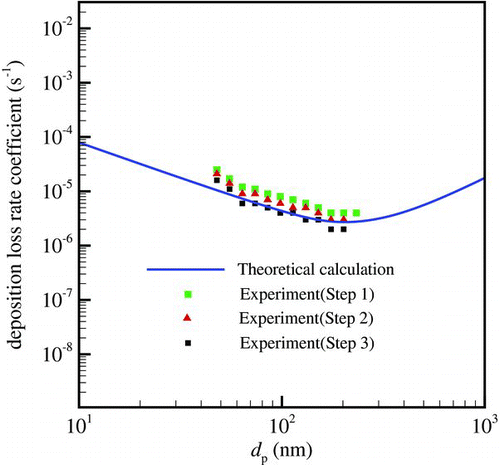
FIG. 6 Bi-modal aerosol size distribution and |γ| with respect to particle diameter. (Color figure available online.)
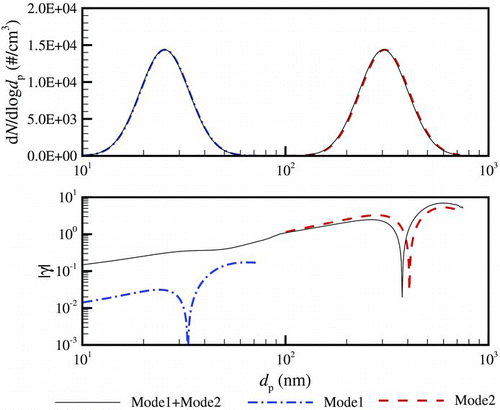
FIG. 7 The evolution of the particle size distribution as well as its total particle number concentration in a bi-modal log-normal system. (Color figure available online.)
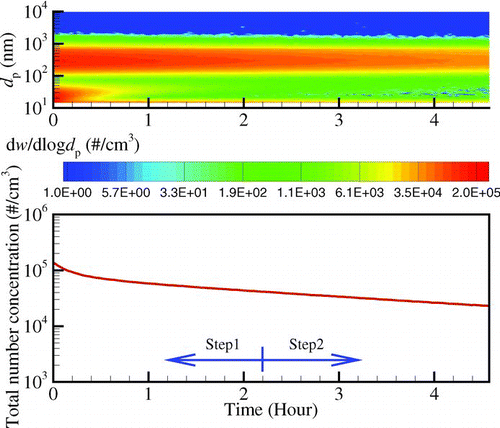
In some cases, the aerosol in experimental studies follows a bi-modal log-normal distributions rather than a uni-modal log-normal distribution (Lee and Wu Citation2005; Seipenbusch et al. Citation2008). In Koivisto et al. (2012), the bimodal size distribution was also used to estimate particle deposition loss rate at wide size range. In this case, the ratio of coagulation to deposition over the entire size range will be changed as compared to the uni-modal aerosol. In this study, three aerosol systems were investigated and compared to each other, i.e., one is a uni-modal aerosol with GMD = 25.4 nm (mode1), another is a uni-modal aerosol with GMD = 306.3 (mode2), and the last is the combined system by the sum of the above two uni-modals (mode1+mode2). The geometric standard deviations are the same for the two uni-modal aerosols, σg = 1.32, with the same total particle number concentration, 1.0 × 104 cm−3. For the combined bi-modal system, the total particle number concentration is 2.0 × 104 cm3. Here, the GMD and the total particle number concentration of the bi-modal aerosol are nearly the same as the aerosol in , ensuring the consistency of the theoretical and the experimental studies for this kind of size distribution.
In , the particle size distributions as well as the value of |γ| are shown and compared to each other for the above three modes. The value of |γ| in the bi-modal system is clearly larger than that in the uni-modal system where mode1 dominates (∼10–∼60 nm), even though the total particle number concentrations for mode1 and mode1+mode2 are nearly the same in this size range (∼10–∼60 nm). In the high size range where mode2 dominates (∼100–∼700 nm), the difference of |γ| is slight between mode2 and mode1+mode2. This may be because the presence of large particles has a strong scavenging effect on small particles, while the inverse effect is slight. According to the basic knowledge on coagulation, the scavenging effect becomes more important with the larger difference of GMD between two modes. In theory, the scavenging effect of larger particles to small particles inevitably leads to the increase of particle number loss in the small size range. This directly leads to the presence of high |γ| in this range, even though the total particle number concentration is very low. According to this theory and the observation in , a conclusion can be drawn that an aerosol with wide size distribution may not be suitable for the estimation of deposition rate coefficient, at least the measured data points in the low end of the size range are not recommended to be used as candidate to estimate particle deposition loss rate. This observation is also available in the experimental studies in .
3.2. Data Analysis with Support of Theoretical Studies
With the support of the criterion with |γ|⩽0.3, the potential to be used in estimating deposition loss rate coefficient for measured data can be correctly evaluated. In the present work, the criterion was applied to evaluate the measurement in Koivisto et al. (2012). The measured data, Appendix B, is available online at http://dx.doi.org/10.1016/j.jaerosci.2011.12.007. Three separated experiments were conducted in which two are the studies on uni-modal size distribution and one is the study on bi-modal log-normal aerosol, which correspond to the data files of F7.txt, Test2.txt, and F12.txt, in Appendix B in Koivisto et al. (2012), respectively. The deposition rate coefficient was estimated using the following equation (Koivisto et al. Citation2012),
shows the particle size distribution as well as the total particle number concentration with time using the measured data file of F7.txt. Due to coagulation, ventilation and deposition, the total particle number concentration decreases with time, but the GMD increases correspondingly. It has been pointed out that the measurement in is nearly the same as D2 in in their GMD and GSD, and thus the measured data should be equal to or less than ∼1.0 × 104 cm−3 in its total particle number concentration to satisfy the criterion with |γ|⩽0.3. In , the whole measured data were divided into four steps, and for each step 25 measured data points were employed. With the requirement of the criterion with |γ|⩽0.3, it was found only the measured data in Steps 3 and 4 had the potential to estimate deposition loss rate coefficient. For Steps 1 and 2, however, the total particle number concentration at each measured data point is more than ∼1.0 × 104 cm−3, and thus these measured data cannot satisfy the criterion with |γ|⩽0.3. When the EquationEquation (7) was solved based on the measured data points from Steps 3 and 4, the deposition loss rate coefficients were obtained, which are shown in . It is obvious that Steps 3 and 4 produce the nearly same estimation for the deposition loss rate coefficient, fitting to the theoretical deposition loss rate coefficient with the friction velocity of 0.9 cm/s inside the chamber, which is also the friction velocity when proposing the criterion with |γ|⩽0.3 in and . In theory, if coagulation is negligible, the estimated deposition rate coefficient should be the same, regardless of the specific measured data points. Based on this, the agreement of estimated deposition rate coefficients between Steps 3 and 4 means that the estimated deposition rate coefficient in these two steps should be or approach the real deposition rate coefficient in the present chamber study, i.e., the measured data points in Steps 3 and 4 produce the correct estimation. This confirms the validation of the criterion with |γ|⩽0.3. In , the estimations for the deposition loss rate coefficient from other measured data points (Steps 1 and 2) whose total particle number concentrations are partially or totally more than 1.0 × 104 cm−3 are also shown. For these two steps, the measured data overestimate the deposition loss rate coefficient. Especially, from the comparison of Step 1 and Step 2, the measured data with higher total particle number concentration lead to the larger deviation from the real estimation. It should attribute to the fact that coagulation plays more and more important role in determining the loss of particle number concentration with the increase of total aerosol number concentration.
shows the evolution of the particle size distribution as well as its total particle number concentration with time measured by the SMPS when the aerosol size is relatively larger as compared to the aerosol in . The aerosol used here is the data file of Test2.txt in Appendix B in Koivisto et al. 2012 which is nearly the same as D3 in in its GMD and GSD. Based on the conclusion from and , the measured data in to estimate deposition loss rate coefficient should be less than that in in its total particle number concentration to satisfy the criterion with |γ|⩽0.3. Similar to the disposition in , the whole measured data points (from point a) were divided into three steps in , and within each step 30 measured data points were employed. Based on the requirement for the less total particle number concentration as compared to that in , the measured data in Step 3 should be the most potential candidate among all three steps. As EquationEquation (7) was solved based on the measured data in Step 3, the deposition loss rate coefficient was obtained, which is shown in . It is obvious that the measured data in Step 3 produce the nearly same predication for the deposition loss rate coefficient with the measured data in at the same chamber and the same turbulent condition, meaning the selection of Step 3 as candidate to estimate deposition loss rate coefficient is reasonable. In addition, in , the deposition loss rate coefficient based on the measured data in Steps 1 and 2 are also shown. However, both Steps 1 and 2 overestimate the deposition loss rate coefficient, even though the total particle number concentration at each measured data points in these two steps is always less than 1.0 × 104 cm−3. Therefore, in order to produce a reasonable estimate for the deposition rate coefficient, the candidate aerosol total number concentration should be decreased with the increase of GMD, which further proves that the previously employed criterion for the negligence of coagulation based solely on the total particle number concentration is insufficient to accurately judge whether an aerosol is suited for the estimation of the deposition rate coefficient.
FIG. 9 Comparison of the estimated deposition rate coefficient among two steps. (Color figure available online.)
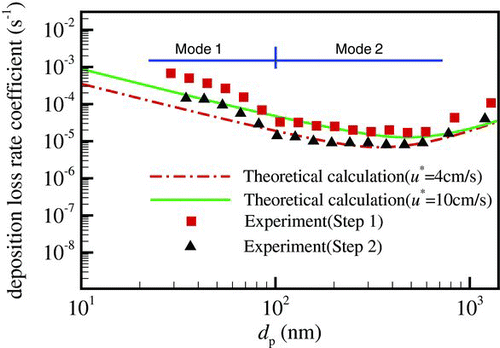
In order to study whether an aerosol with wide size distribution can be used as candidate to estimate the deposition loss rate coefficient, the bi-modal aerosol system was applied here. shows the evolution of an aerosol with bi-modal aerosol size distribution as well as its total particle number concentration measured by the SMPS and the WELAS, and correspondingly shows the estimated deposition rate coefficient based on this bi-modal aerosol system. Here, two operations were conducted for the estimation of deposition loss rate coefficient using EquationEquation (7). In the first operation (Step 1), the measured data points are ones with time less than 2.2 h, while in the second operation (Step 2), the measured data points are ones with time more than 2.2 h. It should be pointed out here in the size range where mode1 dominates (∼10–∼60 nm), the total particle number concentration is less than ∼1.0 × 104 cm−3. The deposition loss rate coefficient is higher for Step 1 than for Step 2 due to the innegligible coagulation, but at each step it is overestimated in the low end of the size range (Mode1 dominates) as compared to the theoretical value. The same conclusion has been observed in the size-resolved theoretical studies in . This shows, the aerosol with wide size distribution may not be suitable for estimating deposition rate coefficient because large particles have a significant scavenging effect on relatively smaller particles, which usually leads to an overestimation of deposition loss rate coefficient in the low end of the size distribution, even though the total particle number concentration of the aerosol is very low. Therefore, wide size distributions are not recommended for use in the estimation of the deposition rate coefficient.
4. CONCLUSIONS
Deeply understanding the fundamental properties of the ratio of coagulation to deposition rates for different aerosol size distributions plays an important role in the proper selection of aerosols to estimate the deposition rate coefficient. Based on the theoretical analysis on the ratio of coagulation to deposition and experimental studies on aerosols using the SMPS and WELAS, the existing criterion with only the particle number concentration is found to be insufficient in the judgment of whether coagulation can be ignored as compared to deposition. For aerosols in a ventilated chamber, the variation of ratio of coagulation to deposition is found to be up to several orders in magnitude due to the change of particle size. In the size range where Brownian and turbulent diffusion are dominant, the ratio of coagulation to deposition becomes more and more significant with the increase of the particle size, but it is inversed in the size range where sedimentation predominates. For a candidate nanoparticle aerosol in the estimation of the deposition rate, the measured total particle number concentration is required to decrease with an increase of the geometric mean diameter. Due to the strong scavenging effect of large particles to small particles, aerosols with wide size distributions are not recommended for use in the estimation of the deposition rate coefficient. This study provides a method to understand the role of coagulation and deposition in the indoor environments.
Acknowledgments
The authors would like to thank Professor Hussein, University of Jordan, for his valuable suggestions for this work, and the Alexander von Humboldt Foundation for financial support. Dr. Yu also would like to thank the financial support of Major Program of the National Natural Science Foundation of China with No. 11132008, and the National Natural Science Foundation of China with No. 10802083.
REFERENCES
- Chan , T. L. , Lin , J. Z. , Zhou , K. and Chan , C. K. 2006 . Simultaneous Numerical Simulation of Nano and Fine Particle Coagulation and Dispersion in a Round Jet . J. Aerosol Sci. , 37 ( 11 ) : 1545 – 1561 .
- Friedlander , S. K. 2000 . Smoke, Dust and Haze: Fundamentals of Aerosol Dynamics, 2nd ed , Oxford University Press, New York .
- He , C. , Morawska , L. and Gilbert , D. 2005 . Particle Deposition Rates in Residential Houses . Atmos. Environ. , 39 ( 21 ) : 3891 – 3899 .
- Hussein , T. , Aleš , Hruška , Dohányosová , P. , Džumbová , L. , Hemerka , J. Kulmala , M. 2009 . Deposition Rates on Smooth Surfaces and Coagulation of Aerosol Particles Inside a Test Chamber . Atmos. Environ. , 43 ( 4 ) : 905 – 914 .
- Hussein , T. , Smolik , J. , Kerminen , V.-M. and Kulmala , M. 2012 . Modeling Dry Deposition of Aerosol Particles onto Rough Surfaces . Aerosol Sci. Technol. , 46 ( 1 ) : 44 – 59 .
- Koivisto , A. J. , Yu , M. , Hämeri , K. and Seipenbusch , M. 2012 . Size Resolved Particle Emission Rates from an Evolving Indoor Aerosol System . J. Aerosol Sci. , 47 : 58 – 69 .
- Koivisto , A. J. , Hussein , T. and Tuomi , T. 2010 . Impact of Particle Emissions of New Laser Printers on Modeled Office Room . Atmos. Environ. , 44 : 2140 – 2146 .
- Lai , A. C. K. 2002 . Particle Deposition Indoors: A Review . Indoor Air , 12 ( 4 ) : 1 – 13 .
- Lai , A. C. K. 2006 . Particle Deposition and Decay in a Chamber and the Implications to Exposure Assessment . Water Air Soil Poll. , 175 ( 1–4 ) : 323 – 334 .
- Lai , A. C. K. , Byrne , A. J. H. and Goddard , M. A . 2002 . Experimental Studies of the Effect of Rough Surfaces and Air Speed on Aerosol Deposition in a Test Chamber . Aerosol Sci. Technol. , 36 : 973 – 982 .
- Lai , a. and Nazaroff , W. 2005 . Supermicron Particle Deposition from Turbulent Chamber Flow onto Smooth and Rough Vertical Surfaces . Atmos. Environ. , 39 ( 27 ) : 4893 – 4900 .
- Lai , A. C. K. and Nazaroff , W. W. 2000 . Modeling Indoor Particle Deposition from Turbulent Flow onto Smooth Surfaces . J. Aerosol Sci. , 31 ( 4 ) : 463 – 476 .
- Lee , S.-R. and Wu , C.-Y. 2005 . Size Distribution Evolution of Fine Aerosols Due to Intercoagulation with Coarse Aerosols . Aerosol Sci. Technol. , 39 ( 4 ) : 358 – 370 .
- Lin , J. Z., , Chan , T.L. , Liu , S. , Zhou , K. , Zhou , Y. and Lee , S.C. 2007 . Effects of Coherent Structures on Nanoparticle Coagulation and Dispersion in a Round Jet . Int. J. Nonlin. Sci. Num. Simul. , 8 ( 1 ) : 45 – 54 .
- Nazaroff , W. W. and Cass , G. R. 1984 . Mathematical Modeling of Indoor Aerosol Dynamics . ES&T Res. , 23 : 157 – 166 .
- Riley , W. J. , McKone , T. E. , Lai , A. C. K. and Nazaroff , W. W. 2002 . Indoor Particulate Matter of Outdoor Origin: Importance of Size-Dependent Removal Mechanisms . Environ. Sci. Technol. , 36 ( 2 ) : 200 – 217 .
- Rim , D. , Green , M. , Wallace , L. , Persily , A. and Choi , J.-I. 2012 . Evolution of Ultrafine Particle Size Distributions Following Indoor Episodic Releases: Relative Importance of Coagulation, Deposition and Ventilation . Aerosol Sci. Technol. , 46 ( 5 ) : 494 – 503 .
- Schripp , T. , Wensing , M. , Uhde , E. , Salthammer , T. , He , C. and Morawska , L. 2008 . Evaluation of Ultrafine Particle Emissions from Laser Printers using Emission Test Chambers . Environ. Sci. Technol. , 42 ( 12 ) : 4338 – 4343 .
- Seipenbusch , M. , Binder , a. and Kasper , G. 2008 . Temporal Evolution of Nanoparticle Aerosols in Workplace Exposure . Ann. Occup. Hyg. , 52 ( 8 ) : 707 – 716 .
- Thatcher , T. L. , Lai , A. C. K. , Moreno-Jackson , R. , Sextro , R. G. and Nazaroff , W. W. 2002 . Effects of Room Furnishings and Air Speed on Particle Deposition Rates Indoors . Atmos. Environ. , 36 : 1811 – 1819 .
- Whitby , K. T. 1978 . The Physical Characteristics of Sulfur Aerosols . Atmos. Environ. , 12 : 135 – 159 .
- Xu , M. , Nematollahi , M. and Sextro , R. G. 1994 . Deposition of Tobacco Smoke Particles in a Low Ventilation Room . Aerosol Sci. Technol. , 20 : 37 – 41 .
